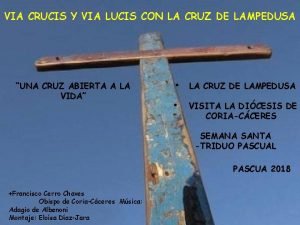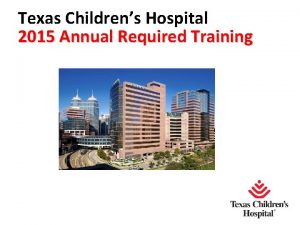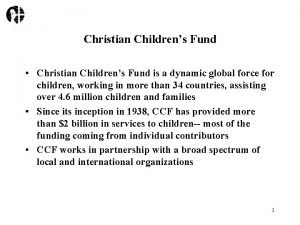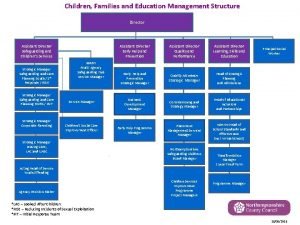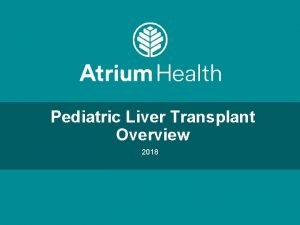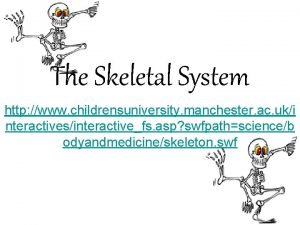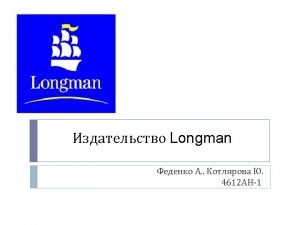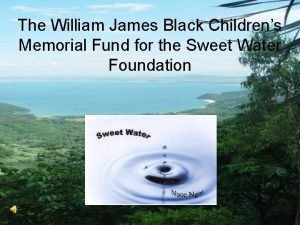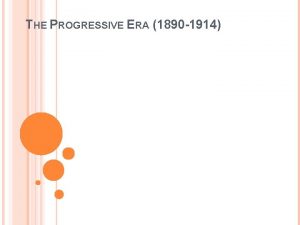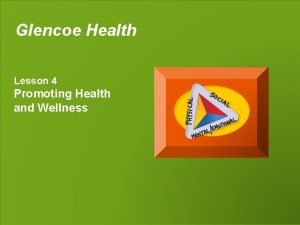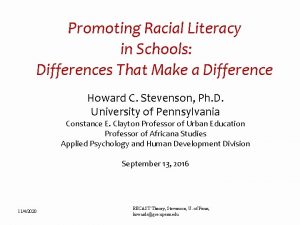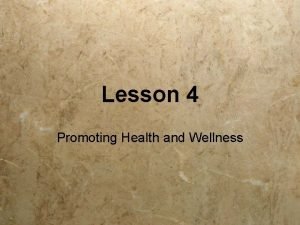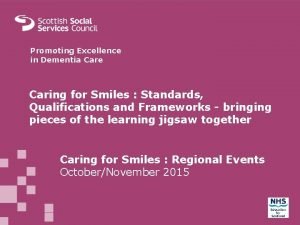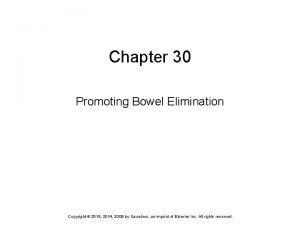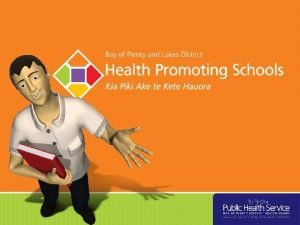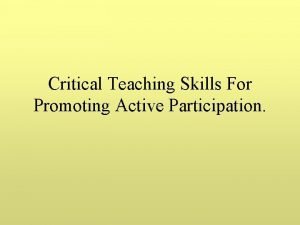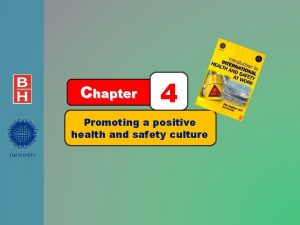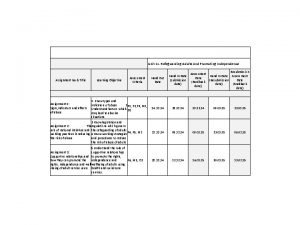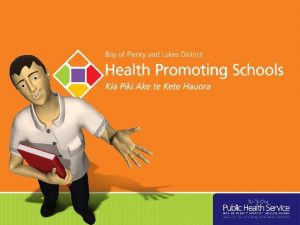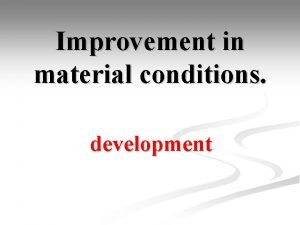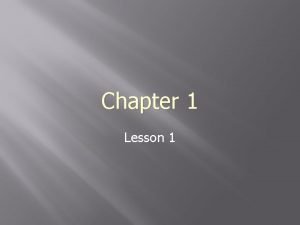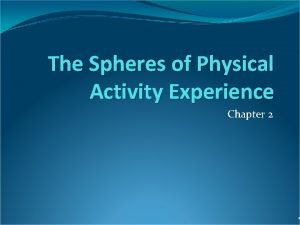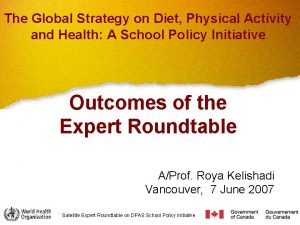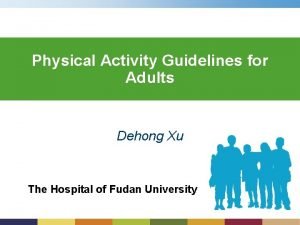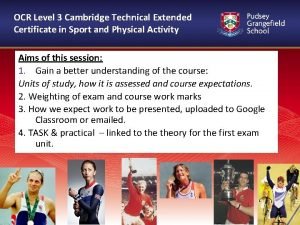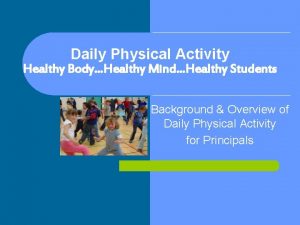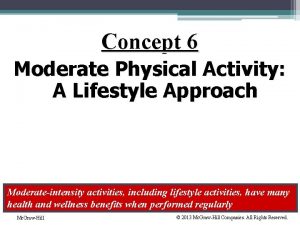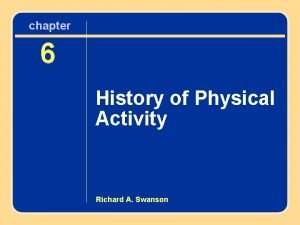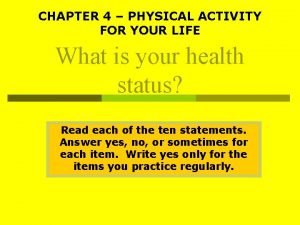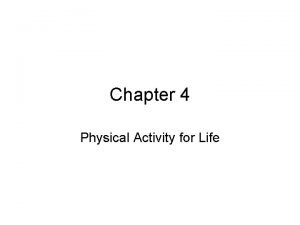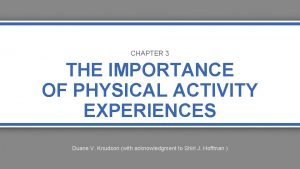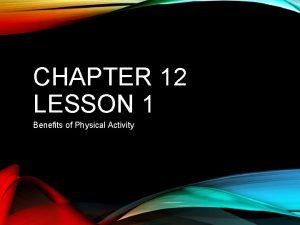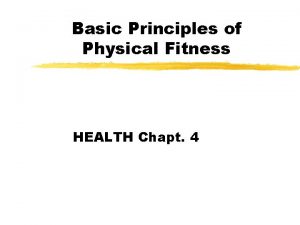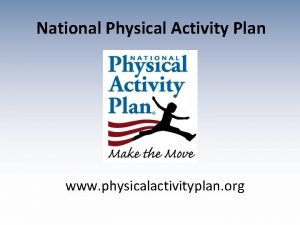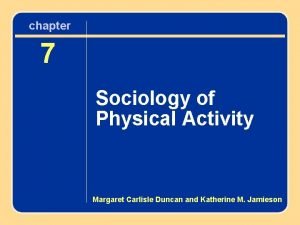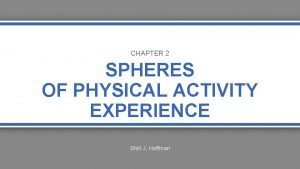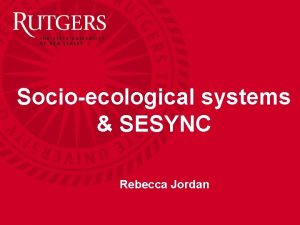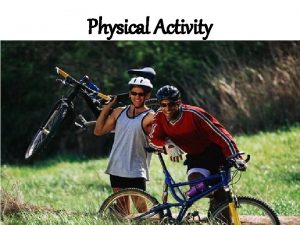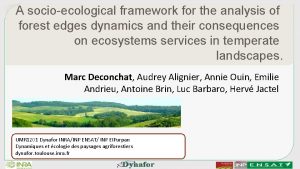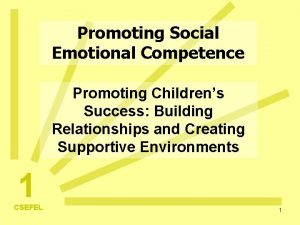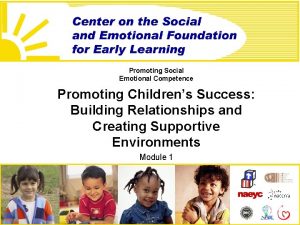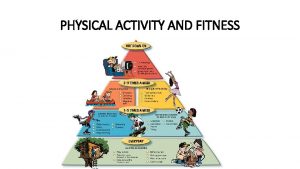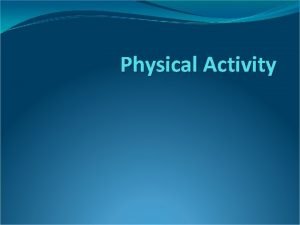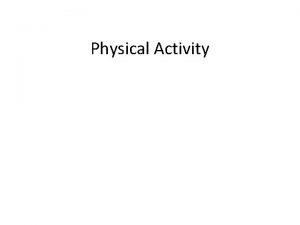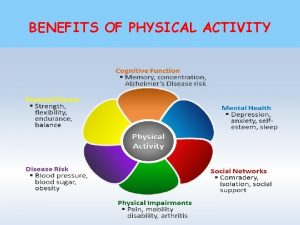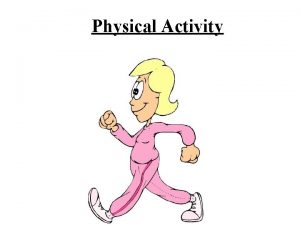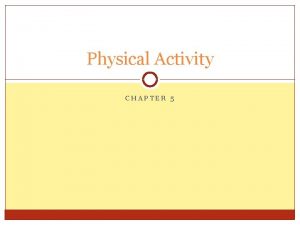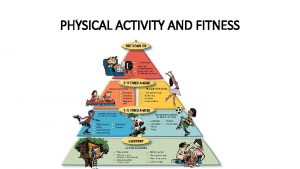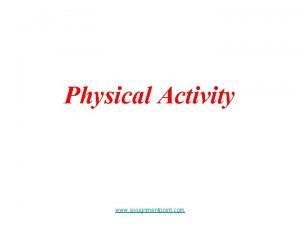Promoting Childrens Physical Activity via a SocioEcological Framework













































































- Slides: 77

Promoting Children’s Physical Activity via a Socio-Ecological Framework Andrew Springer, Dr. PH Assistant Professor, University of Texas SPH-Austin Michael & Susan Dell Center for Advancement Healthy Living Building Bridges Conference- TDSHS, June 16, 2010 of

Topics Ecological perspectives for PA School-based health promotion strategies for PA Examples of partnerships to promote PA in children

Trends in U. S. Child Obesity *Obesity is > 95 th Percentile for BMI by Age/Sex HP 2010 Goal Sources: Ogden et al. , 2006; Hoelscher et al, SPAN 2004 -05 study; CATCH ‘ 07.

Physical Activity “If there were a single medication you could take – a pill that is free, with no side effects – that helped reduce your risk of developing or dying from many chronic diseases, would you take it? Daily physical activity is that magic pill. ” -Jane Wargo & Russell Pate

Benefits of PA for children Chronic disease prevention Mental health, • Hypertension, type 2 diabetes, psychological and obesity, CVD. emotional well-being • Improves overall health and adult health status Cardiovascular system Musculoskeletal system IOM, 2005 • Reduces stress & symptoms of depression and anxiety • Improves self-esteem

PA Guidelines for Children & Adolescents (ages 6 -17) v 1 hour or more of PA every day. v. Most of the 1 hour should be MPA or VPA v. Vigorous intensity activity on at least 3 days per week. v. Muscle-strengthening and bone-strengthening activity on at least 3 days/ week. (USDHHS 2008)

Healthy People 2010 Goals Travis County CATCH Study ‘ 06 -’ 10 Healthy People (HP) 2010: 50% MVPA in PE • 39. 1% MVPA in PE (3 rd, 4 th, 5 th graders). HP 2010 Goal: 85% of children (adolescents) engage in VPA on 3 or more days/wk. • 67% of girls & 74% of boys (n= 1381 4 th graders). American Academy of Pediatrics: 1 -2 hrs/day • 43% of girls & 65% of boys spent ≥ 3 hrs watching TV/playing video games (4 th grade). Hoelscher, Springer et al, 2010

How do we increase physical activity in children and adolescents?

Health Promotion: An Historical Perspective The La. Londe Report (1974): “The Genesis of Health Promotion” First report from industrialized nation: health is not determined only by biological factors. Recognition that biomedical interventions are not the main cause of well-being of a population. “Field of Health” influenced by 4 aspects: Human biology Environment Health services Lifestyles Sallis & Owen, 1997

Health Promotion: An Historical Perspective The Ottawa Charter for Health Promotion (1986): 1 st Int’l conf. on health promotion. • Importance of socio-cultural and economic influences of health. • 5 areas of action: Re-orienting health services toward prevention Building healthy public policy Creating supportive environments Strengthening community action Developing personal skills

Ecological Fallacy Ecological Fallacy: inferences about the nature of individuals are based solely upon aggregate statistics for the group to which those individuals belong. Yum! Example: Florida sells the most cat food and has the most senior citizens = senior citizens eat cat food.

Reductionist Fallacy Reductionist Fallacy: incorrect conclusions about group-level processes are based on individual-level data. • Example: Race causes violence because higher arrests for violent crime among African Americans. • 40% of poor Blacks live in areas of extreme poverty vs. 7% of poor whites. (Wilson, 1987)

Racial/Ethnic Disparity in PA & School Ethnic Composition (Richmond et al. , 2006, Pediatrics) Racial/Ethnic disparities in physical activity. Cross-sectional analysis of 17, 007 teens in the Nat’l Longitudinal Study of Adolescent Health. Findings: Participants attended segregated schools: • 80% of Hispanic students attended schools with student populations that were majority white (66%) • Nearly 40% of the white adolescents attended schools that were >94% white. • Black/Hispanic students attended poorer schools

Racial/Ethnic Disparity in PA Findings (continued) Black and Hispanic adolescent girls reported lower PA than white girls. Black and Hispanic adolescent girls were more likely to attend poorer schools with lower levels of physical activity No difference within schools between black, white, and Hispanic girls’ PA levels. Within the same schools, black and Hispanic boys had >PA when compared to white boys.

Conclusion Lower physical activity levels in Hispanic and black girls largely attributable to the schools they attended. Black and Hispanic males had higher activity levels than white males when attending the same schools. Future research is needed to determine the mechanisms through which school environments contribute to racial/ethnic disparities in adolescent physical activity

Physical Activity by Parental Language Group & Ethnicity Objective: To compare PA participation in children by parental language and ethnicity: (Spanish-Hispanic, English-Hispanic, and English Other). Methods: Cross-sectional analysis of SPAN 2004 -05 data (n = 22, 049 4 th, 8 th, 11 th graders) Springer, Barroso , et al. , J Immigrant Minority Health 2010

% of Texas Girls who Played on ≥ 1 Sports Team at School in last year (n=11, 111; ‘ 04 -05) (Springer, Barroso , et al. , J Immigrant Minority Health 2010) % Span (ref) 1. 00 Eng-Hisp 1. 52 (1. 23, 1. 88) 1. 67 (1. 36, 2. 04) 1. 71 (1. 40, 2. 10) Eng-Other 1. 46 (1. 18, 1. 80) 2. 58(2. 10, 3. 17) 2. 06 (1. 68, 2. 51)

Why lower PA in Hispanic children? • Acculturation Hypothesis: Culture = Lifestyle • Representative study of 5, 406 ninth-grade students in public schools in Matamoros (Mexico) and Lower Rio Grande Valley (Texas, U. S. ) found similar participation in sports (Perez et al. , ‘ 06). • Familismo: putting family needs before one’s own; Hispanic girls more likely to report child care (Grieser et al. , 2006). • Communication & Social Barrier: Is language a barrier for accessing organized PA? • More English-speaking parents reported receiving communication from school (NHES, 2003) • Discrimination & Exclusion: Is language a target for discrimination by dominant ethnic groups? • Non-English adolescents at >risk of alienation (Yu et al. , 2003) • Lower volunteer opportunities for Sp-speaking parents (NHES, 2003) • Language as Proxy for Economic Status(SES)

Ecological models for understanding engagement in physical activity Definitions Ecology: the interrelationship between organisms and their environment. Environment: space external to individuals Ecological perspective: emphasizes the interaction between people and their physical and socio-cultural surroundings. (the key to ecological models).

Common Principles of Ecological Models of Behavior • Multiple dimensions & levels of influence • Emphasis on place: behavior-specific models. • Environments directly influence behaviors. • Interactions of influence across dimensions. Sallis et al. , 2006; Sallis & Owen, 1997

Ecological Model of Active Living Policy (Sallis et al 2006) Sallis et al. , 2006

Multiple Dimensions & Levels Policy Social Culture Inform. Natural/Built Environment Sallis et al. , 2006

Behavioral Settings Policy Neighborhood Recreation Environment Work place Behavior Settings Perceptions Home Behavior-Specific Models & Settings School Sallis et al. , 2006

Active Living Domains Policy Sallis et al. , 2006

Perceived Environment Policy Sallis et al. , 2006

Intrapersonal Environment Policy Sallis et al. , 2006

Environments Directly Influence Behavior Policy Sallis et al. , 2006

Interactions of Influence across Policy Dimensions Sallis et al. , 2006

Parental Influences on Children’s TV Watching Springer, Kelder, Barroso, Drenner, Shegog, Ranjit, Hoelscher, Under Review v. Study Objective: To assess the association of parental TV rules (policy environment) on children’s meeting AAP guidelines of ≤ 2 hours TV watching/day • Examine potential modifying effect of TV in bedroom (built environ. ), parent TV watching, Afterschool context (social environments) v. Sample: n = 734 primarily Hispanic 4 th graders v. Methods: Self-administered questionnaire

Percentage of Children who met AAP by Parent TV Rules AOR: 1. 68 (1. 22, 2. 32) Adjusted for age, gender, ethnicity, parent language

Percentage of Children who met AAP by TV Rules: TV in Bedroom AOR: 1. 04 (. 50, 2. 19) 2. 03 (1. 39, 2. 97)

Percentage of Children who met AAP by TV Rules: Parental TV Watching AOR: 1. 80 (1. 26, 2. 56) 0. 71 (0. 30, 1. 69)

Summary Policy Environment: Children with Parental TV Limits more likely to meet AAP recommendations Social Environment: Children with high TV watching parents less likely to meet AAP recommendations. Interactions of Influence across Dimensions: • TV location modifies TV rule and AAP • Nonsignificant association when parents watch TV frequently

Schools… “… have more influence on the lives of young people than any other social institution except the family and provide a setting in which friendship networks develop, socialization occurs, and norms that govern behavior are developed and reinforced. ” -Healthy People 2010

Elementary school PE does not harm academic achievement Students who participated in school PA did not experience negative effects on their standardized test scores, though less time was available for other academic subjects. Sallis et al, 1999 Shephard, 1996 Dwyer et al, 1983

2001 Grade 5 SAT 9 and Physical Fitness CA Dept. of Education, 2002

Measurement of Physical Activity (Schools) Self-report: diary, questionnaires, activity checklists (SAPAC) Direct observation (SOFIT, SOPLAY) Pedometers, accelerometers, heart rate monitors.

Strategies for PA promotion in the school setting Intrapersonal • Classroom PA Curriculum Policy/Social Environment • • • Mandated PA time PE Organization/Training (CATCH) Activity Breaks Built Environment Community-School Partnership

Curriculum-Only • Salmon et al. (2007): Review of PA studies. • 5 intervention curriculum-only studies : 1 effective but not effective in replication. • TV curriculum (e. g. , Planet Health) = effects on reducing TV/ weight gain.

Strategies for PA promotion in the school setting Policy/Social Environment Mandated PA Time PE Organization/Training (CATCH) Activity Breaks Built Environment Community-School Partnership

Percentage of U. S. high school students that attend daily PE class, 1991 -2007 CDC YRBS

Texas School PA Policy Texas Senate Bill 19 (2001): K – 5 th grade The Texas Coalition for Coordinated School Health and Physical Education • 30 minutes of daily structured physical activity or a total of 135 minutes/week • Coordinated School Health Program (CSH) • Classroom curriculum, physical activity, child nutrition services, and parental involvement. • Creation of local district School Health Education Advisory Council.

Implementation of Texas Senate Bill 19 in Elementary Schools Kelder SH, Springer AE, Barroso C, Smith C, Sanchez E, Hoelscher DM, Ranjit N. RESEARCH AIMS 1) To assess awareness of and adherence to SB 19 in a representative sample of Texas elementary schools. 2) To assess the implementation of SB 19 in Texas/Mexico border schools (2 regions): • weekly minutes of PA; • quality of child PA during PE.

Reported PE and Recess Min per Week 135 min per week R 10 -R 11 = 82 min/week (Kelder , Springer et al. , J Public Health Policy, 2009)


Selected Policies to Promote PA during School California Legislation: 50% of PE classes to be spent in MVPA by 2013. Increase supervision of recess (Sallis et al. , 2001; Sallis et al. , 2003; Farley et al. , 2007) • CATCH Middle School: Open Gym Provide PA as a reward, not discipline (PLAY-ON study, Leatherdale et al. , 2010). WOW Time: 30 minutes of PA/day (Springer et al. , in progress)

Strategies for PA promotion in the school setting Policy/Social Organization Mandated PA Time PE Organization/Training (CATCH) Activity Breaks Built Environment Community-School Partnership

Healthy People 2010: PE Objective • Students participate in MVPA for >=50% of class time.

CATCH PE Maintain children in high levels of activity. • • All children participate. • Non-competitive, fun activities.

Community Partnerships with CATCH Steps to a Healthier Houston-Harris County Consortium (Steps Consortium) • Formed in 2003; 25 area organizations • The Houston Endowment Inc. awarded $2. 4 million to implement CATCH in >450 schools Travis County CATCH Project • UTSPH & 4 central Texas districts • Funding from Michael & Susan Dell Foundation for implementation in ~100 elementary schools • CATCH Consortium & support of CATCH teams

Percentage of PE Class Time 3 rd, 4 th, & 5 th grade students engaged in MVPA. Harris County CATCH (n = 94 class observations/ 36 schools). 46. 3%* 36. 7%* 41. 6% *p<. 001 (Hoelscher, Springer et al. , in process)

Percentage of PE class time 3 rd, 4 th, and 5 th grade students engaged in MVPA. Travis County CATCH Project. (n = 103 class observations). b, c a, b 38. 8 42. 8 [a: p =. 023; b: p = <. 001; c: p =. 001. ] HP 2010 Goal 48. 4 Hoelscher, Springer, et al. , Obesity 2010

Strategies for PA promotion in the school setting Policy/Social Environment Mandated PA Time PE Organization/Training (CATCH) Activity Breaks Built Environment Community-School Partnership

Activity Breaks • • • “Promoting Lifetime Activity in Youth” (PLAY) (Pangrazi et al. , 2003; Ernst et al. , 1999) Teacher-led games. (Connolly & Mc. Kenzie, 1995) “Take 10!” (Stewart et al, 2004)

Pass & CATCH improves Stanford math scores At Risk: adaptability, social skills, leadership, study skills, functional communication * Murray (UTSPH), unpublished * *

Active Play Project Investigators: Springer, Kelder, Ranjit; Funding: Michael & Susan Dell Foundation To assess the effect of low-cost strategies for promoting children’s MVPA during recess and WOW time. Strategies: • Peer-led Games Approach • Teacher-led Approach • Playground Markings Design: RCT in 8 schools


Strategies for PA promotion in the school setting Policy/Social Environment Mandated PA Time PE Organization/Training (CATCH) Activity Breaks Built Environment Community-School Partnerships

Built Environment “We shape our buildings, and thereafter they shape us. ” -Winston Churchill (1874 -1965)

“As drivers expand, car makers develop new designs. ” . Boston Globe, 2005

“Supports your ‘sit bones’…!” =

Playground Markings v. Stratton (2000): Children 5 -7 yrs (UK). MVPA increased by 18 mins/d. v. Stratton & Mullan (2005): 4 -11 yrs: MVPA increased from 37% to 50%. v. Ridgers et al. (2007)

Playground Equipment & Enhancements Games equipment & activity cards intervention increased MVPA in 5 th/6 th grade girls in Belgian. (Verstraete et al, 2006). Middle school students attending schools with improved playgrounds had higher observed MVPA (Sallis et al. , 2001).

Strategies for PA promotion in the school setting Policy/Social Environment Mandated PA Time PE Organization/Training (CATCH) Activity Breaks Built Environment Community-School Partnerships

Community-School Partnerships • Schools and communities have long been cited as important vehicles for promoting PA in young people (IOM, 2006; USDHHS, 1996) • Partnerships among schools, community organizations and businesses: recommended to implement PA programs (CDC, 1997). • PLAY-ON study (n = 30 schools; 2, 379 5 -8 graders): children more likely to be moderately active if attending a school with well-established community partnerships (Leatherdale et al. , 2010)

Marathon Kids • Established 1996 in Austin, Texas. • Currently operating in 7 sites in the U. S. Objectives: • To engage children (and families) in running/walking 26. 2 miles over six month period. • To promote children’s consumption of fruit & vegetables 5 times a day/26 days per month.

Goal Setting/ Monitoring Fuel & Mileage Logs

Policy/ Organizational Environment School physical activity legislative mandates (Senate Bill 19/530) Structured School Time for PA • Before, during & after school.

Information Environment Bumper Stickers Marathon Kids T-Shirts Information Packets Presentations Media Coverage

Social Environment: Positive Social Influences Teachers Parents Volunteers/Comm. Leaders; Businesses

Social Environment: Instrumental Support Teachers/Schools: Enroll students in program. Track progress with miles. Facilitate transportation to celebratory events.

Social Environment: Positive Social Influences LA Mayor Antonio Villaraigosa Austin Mayor Will Wynn (Keepin’ Austin Weird…) Shawn Colvin Musician Eduardo Sanchez Texas Health Commis.

Social Environment: Positive Reinforcement Public Recognition = “Kick-Off” and “Final Mile Run Events” Final Mile Medal & Finisher T-Shirt

Selected Findings: MK Study Marathon Kids, Running (p=. 007), 4. 13 Comparison, Running (p=. 007), 3. 63 Marathon Kids, Ate vegetables† (p=. 026), 2. 63 Comparison, Ate vegetables† (p=. 026), 2. 37 Marathon Kids, Ate fruits† (p=. 008) , 3. 31 Comparison, Ate fruits† (p=. 008) , 3. 01 Marathon Kids Comparison Marathon Kids, Athletic Identity† (p=. 0002), 7. 80 Comparison, Athletic Identity† (p=. 0002), 7. 40 Springer, Kelder, Ranjit et al, under review

Summary Beware the ecological fallacy… but also beware of a reductionist fallacy • The sociological imagination: the capacity to discern the relationship between large-scale social forces and the actions of individuals. Ecological Models: a broad framework for exploring social-environmental influences on PA • Too broad? Need to continue to elucidate dimensions of ecological models Schools as a key setting for PA

Building Bridges for Promoting Children’s PA How do we enhance social environment/ social organization of schools to promote child PA? (e. g. , Wellness committees) How do we harness school-community partnerships to increase effectiveness of school policies and quality of PA? How do we expand the focus from individuals to settings (‘active schools’, ‘active school districts’, and active communities)?

THANK YOU
 Physical fitness grade 9
Physical fitness grade 9 Sexta estacion del via crucis
Sexta estacion del via crucis La via negativa
La via negativa ¿cuáles son las estaciones del vía lucis?
¿cuáles son las estaciones del vía lucis? Haz piramidal directo
Haz piramidal directo Palavras convergentes
Palavras convergentes Texas children's hospital moli
Texas children's hospital moli Christian children's fund inc
Christian children's fund inc Childrens services
Childrens services Walsall childrens services
Walsall childrens services Levine childrens
Levine childrens National sovereignty and childrens day
National sovereignty and childrens day Multi agency assessment
Multi agency assessment Childrens literature quiz
Childrens literature quiz Childrens university of manchester
Childrens university of manchester Longman picture dictionary
Longman picture dictionary Black childrens memorial
Black childrens memorial Toddler fever
Toddler fever History of childrens literature
History of childrens literature Colorado childrens book award
Colorado childrens book award Promoting moral improvement
Promoting moral improvement Promoting services and educating customers
Promoting services and educating customers Promoting alternative thinking strategies
Promoting alternative thinking strategies Glencoe health and wellness
Glencoe health and wellness Promoting family earthquake preparedness
Promoting family earthquake preparedness Chapter 1 understanding health and wellness lesson 4
Chapter 1 understanding health and wellness lesson 4 Promoting racial literacy in schools
Promoting racial literacy in schools Lesson 4 promoting health and wellness
Lesson 4 promoting health and wellness Methods of promoting intrapreneurship leaving cert
Methods of promoting intrapreneurship leaving cert Promoting infant health section 7-2
Promoting infant health section 7-2 Promoting excellence in dementia care
Promoting excellence in dementia care What is deontological
What is deontological Chapter 7 promoting health and wellness
Chapter 7 promoting health and wellness Chapter 30 promoting bowel elimination
Chapter 30 promoting bowel elimination Chapter 13 distributing and promoting products
Chapter 13 distributing and promoting products Promoting services and educating customers
Promoting services and educating customers Health promoting schools model
Health promoting schools model Active participation strategies
Active participation strategies Promoting a positive health and safety culture
Promoting a positive health and safety culture Unit 11 safeguarding adults and promoting independence
Unit 11 safeguarding adults and promoting independence National integration and international understanding
National integration and international understanding Institutional support to entrepreneurship development
Institutional support to entrepreneurship development Health promoting school
Health promoting school Japan's principal asset in promoting development is
Japan's principal asset in promoting development is Chapter 1 lesson 4 promoting health and wellness
Chapter 1 lesson 4 promoting health and wellness Dispositional framework vs regulatory framework
Dispositional framework vs regulatory framework Theoritical framework example
Theoritical framework example Theoretical framework maker
Theoretical framework maker Conceptual framework theoretical framework
Conceptual framework theoretical framework Dispositional framework vs regulatory framework
Dispositional framework vs regulatory framework Theoretical framework
Theoretical framework Activity 2 limiting reactants activity
Activity 2 limiting reactants activity Debye huckel limiting law
Debye huckel limiting law Aon to aoa
Aon to aoa Form content and use
Form content and use Activity 1 activity 2
Activity 1 activity 2 Activity 2
Activity 2 1index
1index 7 spheres of physical activity
7 spheres of physical activity Who global strategy on diet, physical activity and health
Who global strategy on diet, physical activity and health Example of vigorous activity
Example of vigorous activity Ocr level 3 sport and physical activity
Ocr level 3 sport and physical activity Moderate physical activity examples
Moderate physical activity examples Fit formula for moderate physical activity
Fit formula for moderate physical activity Between 1950 and 2000 physical activity professions
Between 1950 and 2000 physical activity professions A way of life that includes little physical activity
A way of life that includes little physical activity Chapter 12 lesson 3 planning a personal activity program
Chapter 12 lesson 3 planning a personal activity program Professional experience in physical activity
Professional experience in physical activity Chapter 12 lesson 1 benefits of physical activity
Chapter 12 lesson 1 benefits of physical activity Chapter 12 • lesson 1 benefits of physical activity
Chapter 12 • lesson 1 benefits of physical activity Physical activity pyramid worksheet
Physical activity pyramid worksheet Uk chief medical officers' physical activity guidelines
Uk chief medical officers' physical activity guidelines Ancient near east countries physical education
Ancient near east countries physical education National physical activity plan
National physical activity plan Physical fitness definition
Physical fitness definition Sociology of physical activity focuses on
Sociology of physical activity focuses on Kind of physical activity
Kind of physical activity Spheres of kinesiology
Spheres of kinesiology

